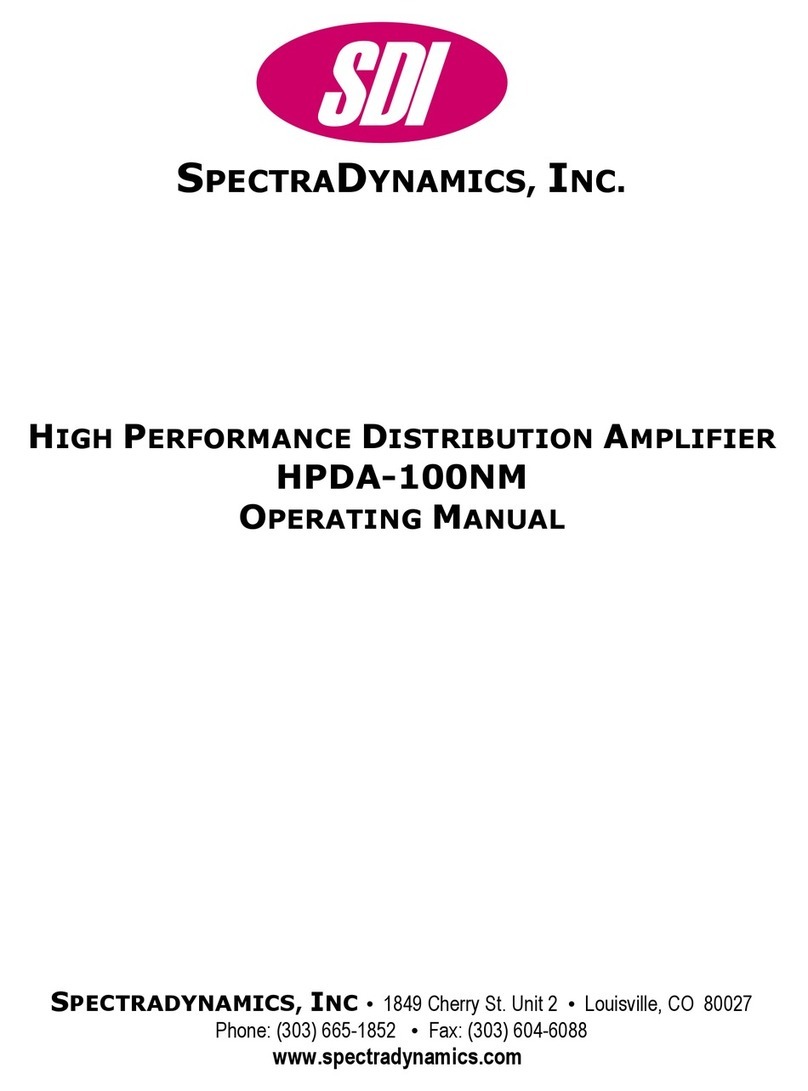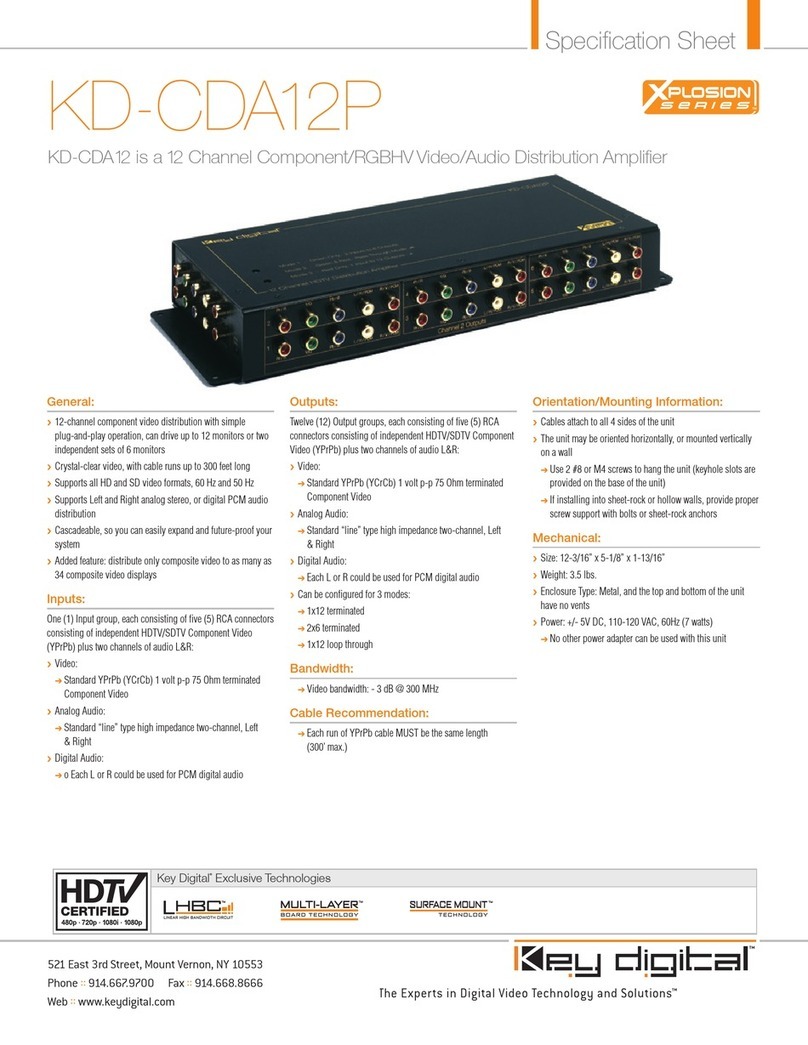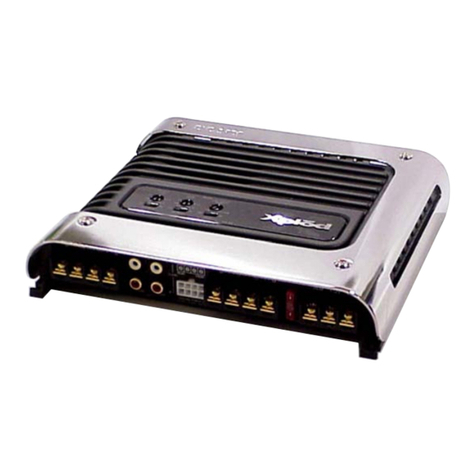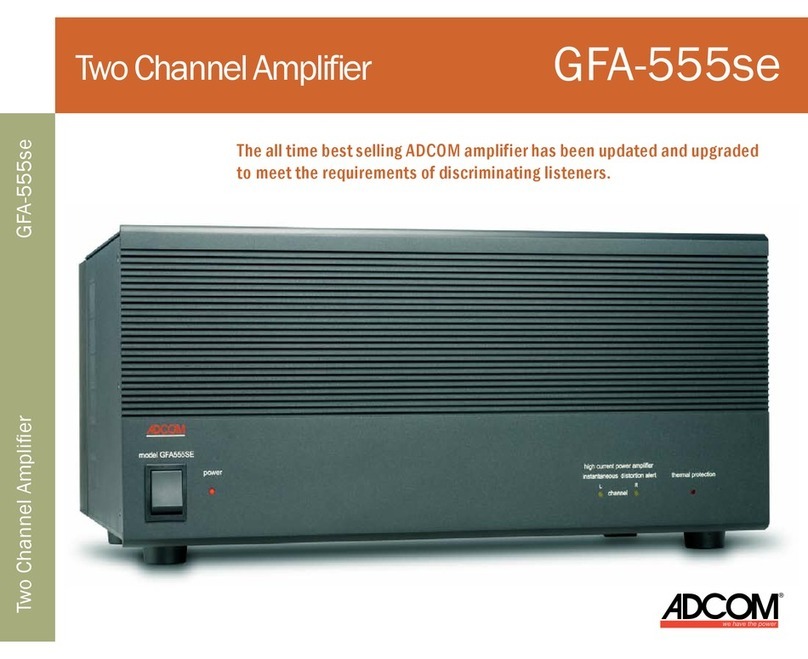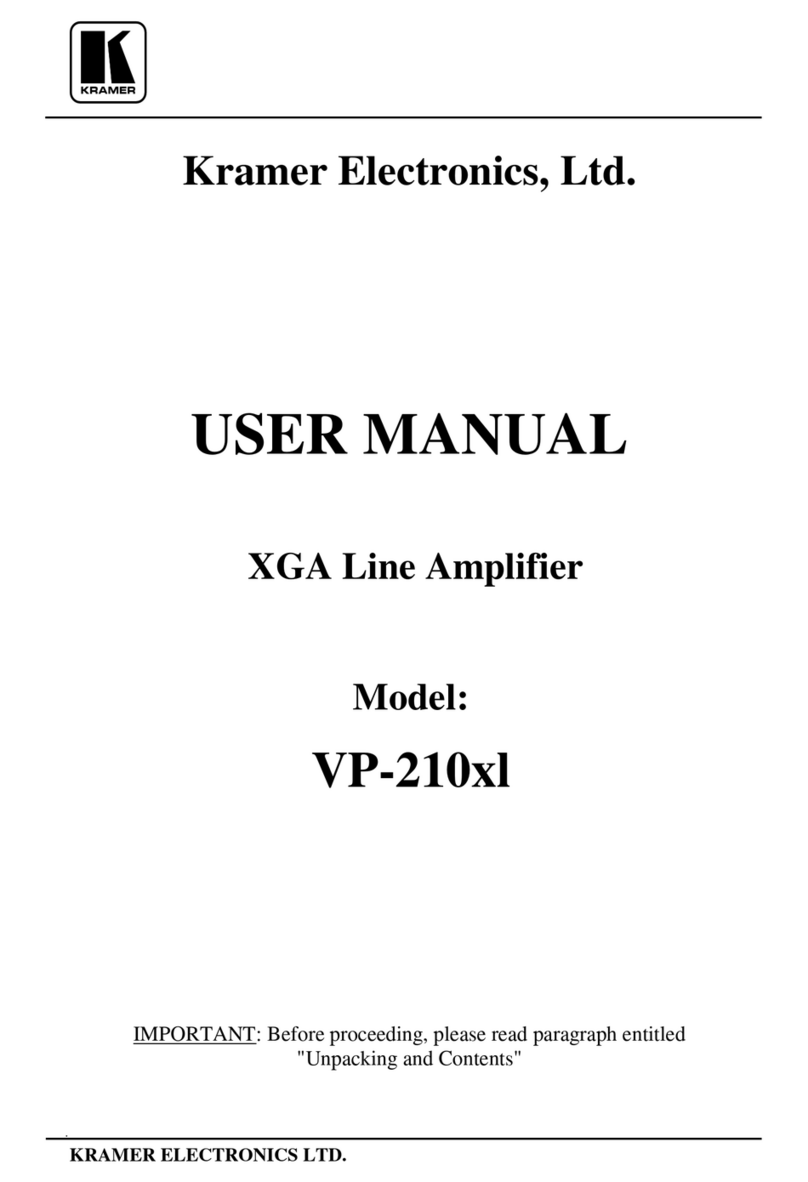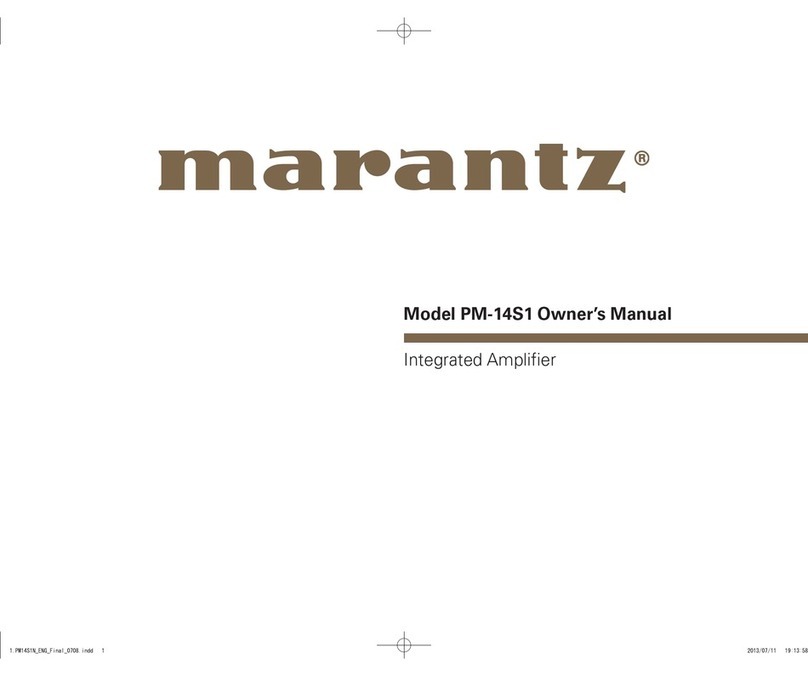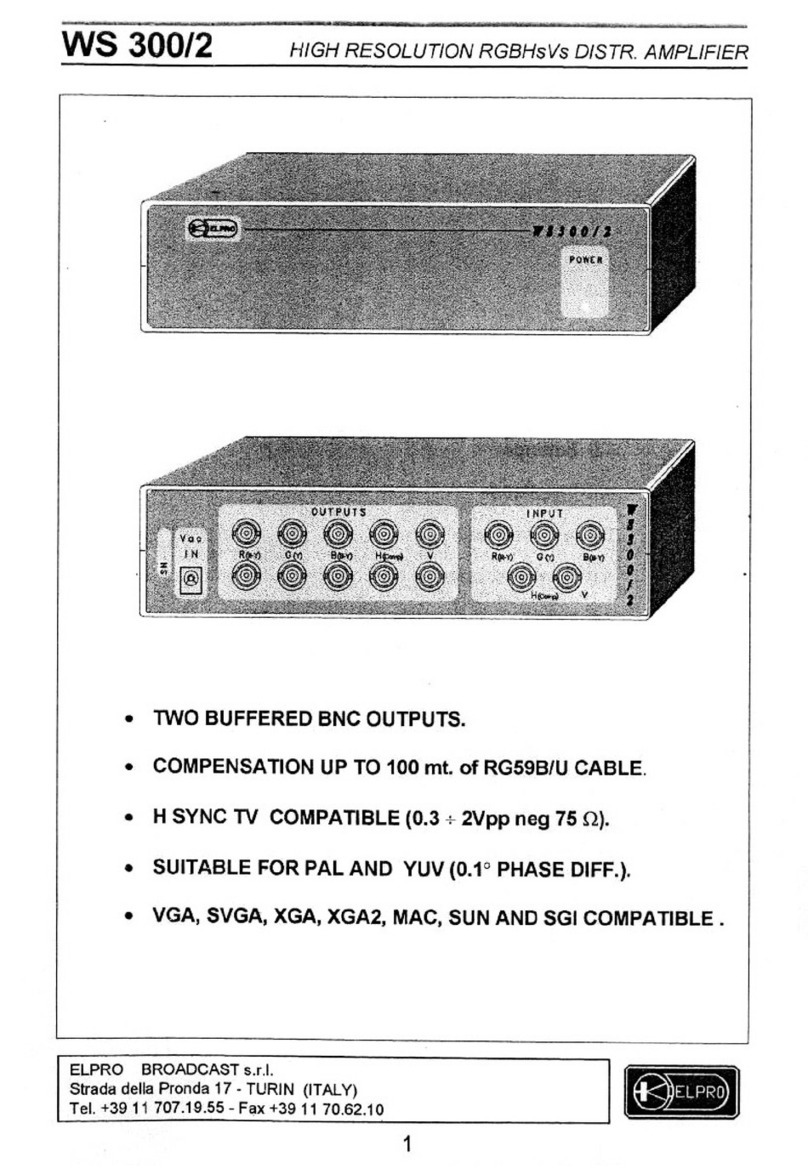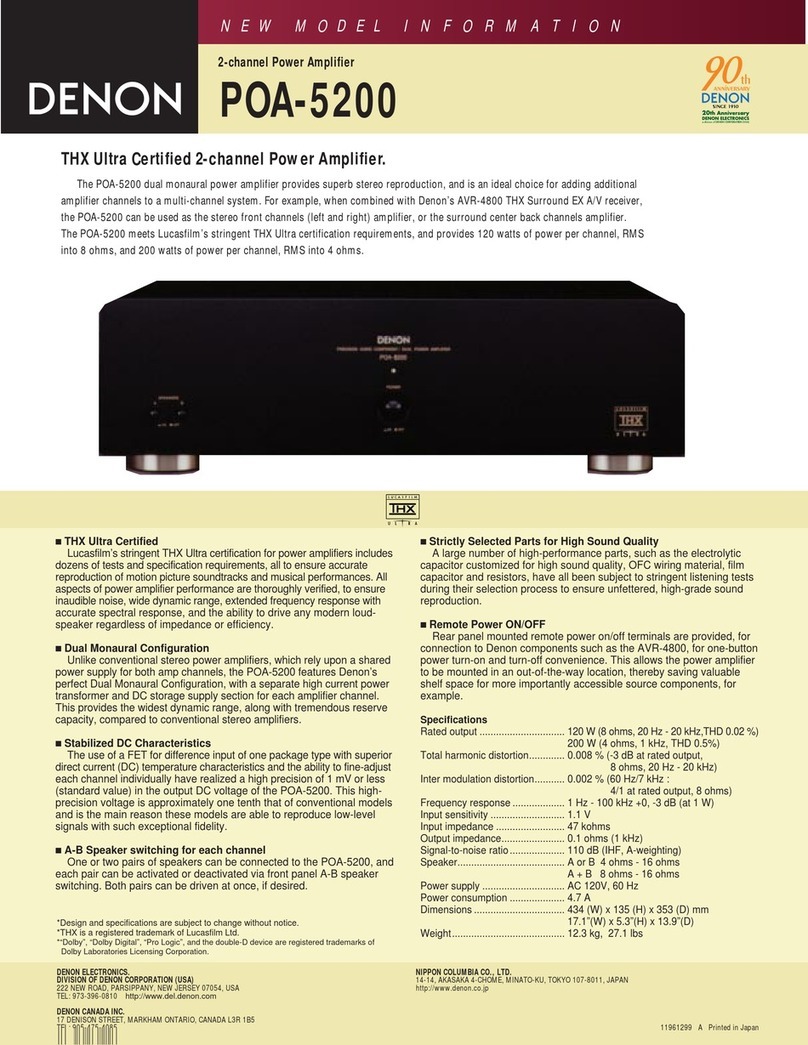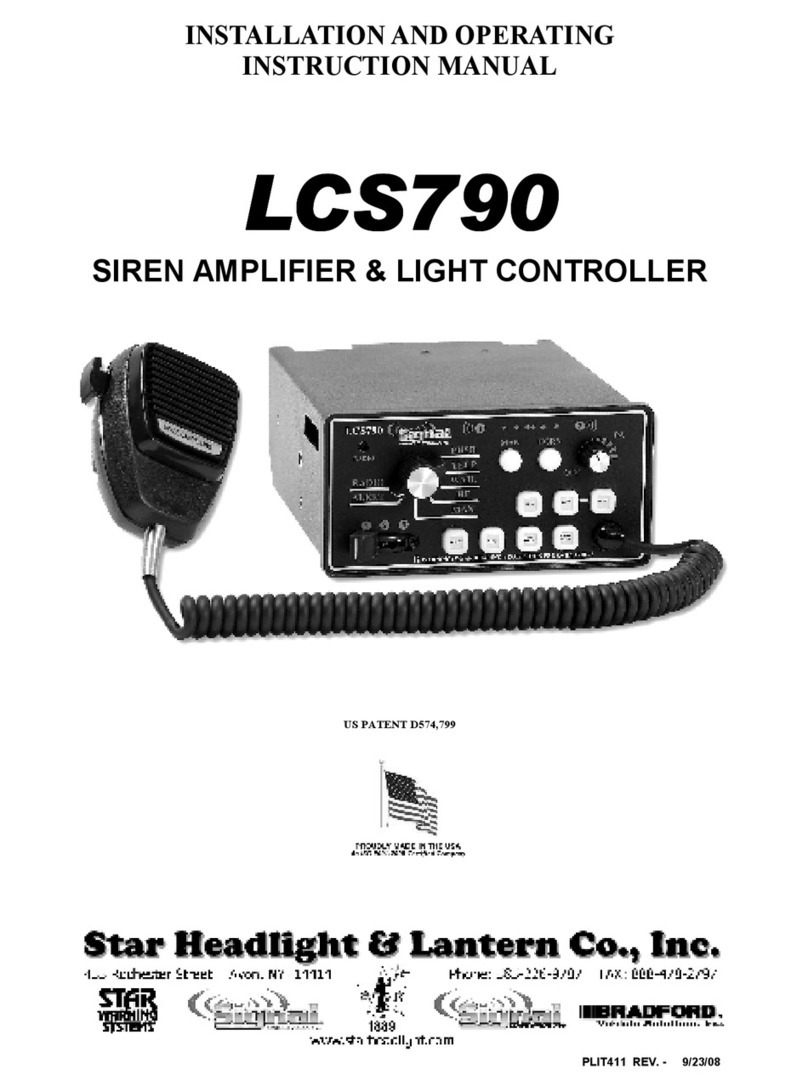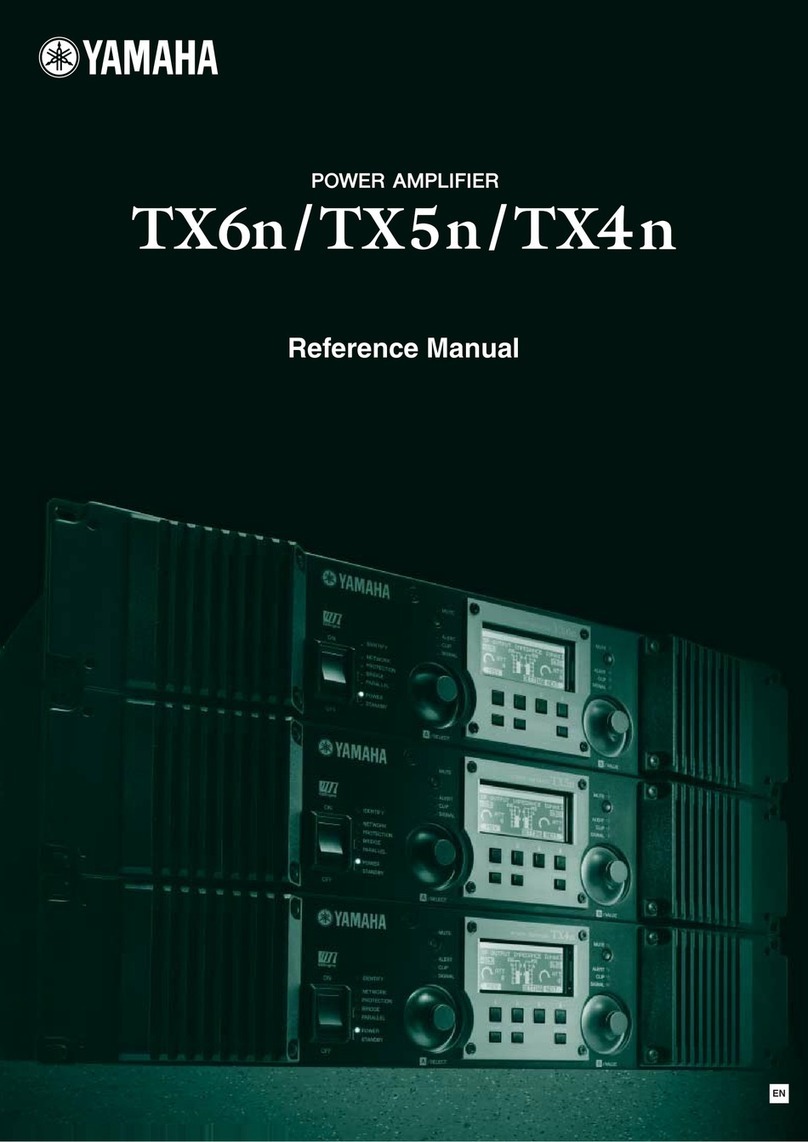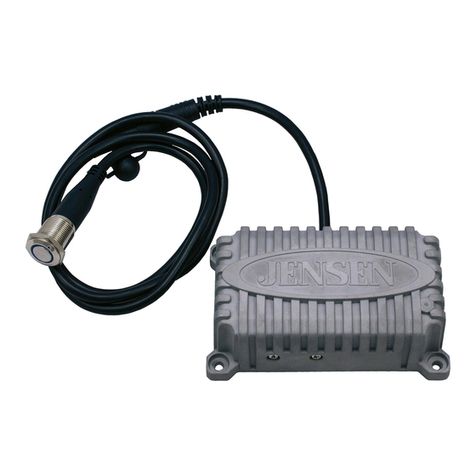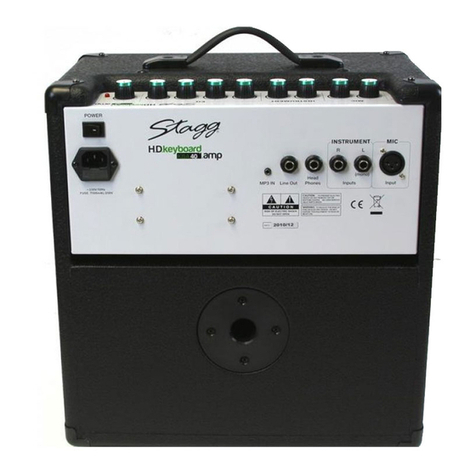Audiofrog A150.4D User manual

A150.4D
4-Channel High Fidelity Class-D Amplier
A600.1D
1-Channel High Fidelity Class-D Amplier
A150.4D
High Fidelity Class-D Amplifier

Controls and Functions (150.4D):
Turn On Mode:
Signal: Senses audio signal on the speaker
level inputs (>800mVp) and on the line lev-
el inputs (>45mVp) to turn on the amplier.
There will be a short delay in turn-off to
accommodate silence between tracks.
Offset: Senses the 6V BTL reference when
the speaker level inputs are connected to
the outputs of a BTL amplier or head unit.
Rem: Senses the remote turn on output of
the head unit or to the car’s ACC circuit.
Crossover Channels 1 and 2 (3 and 4)
Filter Type:
HP: Only the low frequencies below the
High Pass lter frequency selection will be
removed from the signal.
BP: Low frequencies below the High
Pass lter frequency selection and high
frequencies above the Low Pass lter
frequency selection will be removed from
the signal.
None: No high pass or low pass lter will be
applied. All frequencies will pass.
Low Pass Control Group:
50Hz-500Hz: Adjusts the low pass lter fre-
quency to any frequency between 50Hz
and 500Hz. High frequencies above this
selection will be removed.
X1-X10: When this switch is set to X1, the
lter frequency range is 50Hz-500Hz. When
this switch is set to X10, the lter frequency
range is set to 500Hz-5000Hz
High Pass Control Group
20Hz-400Hz: Adjusts the high pass lter fre-
quency to any frequency between 20Hz
and 400Hz. Low frequencies below this
selection will be removed.
X1-X10: When this switch is set to X1, the
lter frequency range is 20Hz-400Hz. When
this switch is set to X10, the lter frequency
range is 200Hz-4000Hz.
Input Cong:
3Ch: Input 1 sends signal to output chan-
nels 1, 3 and 4. Input 2 sends signal to
output 2, 3 and 4. Inputs 3 and 4 are not
used. Outputs 3 and 4 will output the sum
of inputs 1 and 2 (1+2). Use when output
channels 3 and 4 will be bridged to drive a
subwoofer with two input connections.
2Ch: Input 1 sends signal to outputs 1 and
3. Input 2 sends signal to outputs 2 and 4.
Inputs 3 and 4 are not used.
4Ch: Each input sends signal to its corre-
sponding ouput (1-1, 2-2, 3-3, and 4-4).
Level:
Adjusts the voltage sensitivity (level) of
each pair of inputs. For line level input sen-
sitivity, Min is 10Vp and Max is 500mVp.
DO NOT APPLY MORE THAN 30Vp TO THE
SPEAKER LEVEL INPUT CONNECTIONS OR
THE UNIT WILL BE DAMAGED!
Power: This LED will light green to indicate
that the unit is on.
Protect: This LED will light red to indicate
a fault and the amplier will produce no
sound. Faults include: power supply input
voltage is too high or too low, output
connection is short, amplier heat sink
temperature is too high.
Notes about crossover settings: When
using any pair of amplier channels in
BP (bandpass) mode, the HP (high pass)
frequency control MUST be set to a LOWER
frequency than the LP (low pass) frequen-
cy control. For example, if channels 3 and
4 will drive midrange speakers only, the LP
frequency control might be set to 3500Hz
and the HP frequency control might be
set to 100Hz. The signal sent to the speaker
will be frequencies BETWEEN 100Hz and
3000Hz. If there is no ouput from a pair of
channels, check these settings carefully.

Controls and Functions (A600.1D):
The Turn-On Mode and Level control
for the A600.1D operate exactly like the
controls on the A150.4D. The Power and
Protect LED functions are also the same
as the 150.4D. Because the A600.1D is a
single channel amplier designed to drive
low frequency speakers or subwoofers, the
crossover controls are somewhat different
and are explained below.
High Pass 5Hz-40Hz: Adjusts the high pass
lter frequency to any frequency between
5Hz and 40Hz. Low frequencies below this
selection will be removed. For subwoofers
in vented boxes, set this control about a
half an octave below the frequency at
which the enclosure is tuned to prevent
too much excursion from damaging the
speaker. This is also useful for innite bafe
subwoofers. If your system doesn’t require
a high pass lter for the subwoofer, set this
control to its minimum setting (5Hz).
Low Pass 50Hz-500Hz: Adjusts the low pass
lter frequency to any frequency between
50Hz and 500Hz. High frequencies above
this selection will be removed.
Phase 0°-180°: Adjusts the phase of the
output at the crossover frequency be-
tween 0 degrees and 180 degrees. Use
this control to match the phase of the
subwoofer with that of the front speakers
to help blend the sound of the subwoofer
into the sound of the front speakers.
45Hz 0dB-15dB: Adjusts the amount of
45Hz in the output between 0dB and
15dB. Adjust this as you wish but be careful
because too much bass boost can cause
distortion at high output when the am-
plier runs out of available power at high
volume. Each 3dB of boost requires double
the power of the unboosted frequencies.
3dB requires twice the power. 6dB requires
four times the power. 9dB requires eight
times the power. 12dB requires sixteen
times the power and 15dB requires 32
times the power sent to the unboosted
frequencies.
Remote Level Control (optional): This
control, if installed, allows the level of the
output of this amplier to be controlled
from the front of the car. The RLC will vary
the output level of the amplier between
off (fully counter-clockwise) and the level
control setting selected with the level con-
trol on the amplier (above).
Using These Ampliers With a DSP: When
using these ampliers with a DSP, you
can (and should) defeat the A150.4D’s
on-board crossovers by selecting “None”
with the Filter Type switch if the lter will be
implemented in the DSP. When using the
A600.1D with a DSP, adjust the Low Pass
lter to its highest frequency (500Hz) and
the High Pass lter to its lowest frequency
(5Hz) if you will implement the high pass
lter in the DSP. You can also use the high
pass lter in the amplier to protect your
subwoofer from over excursion if your DSP
doesn’t include a high pass lter for the
subwoofer.
When Driving Tweeters Separately in an
Active System: Set the high pass lter
frequency about an octave above the
tweeter’s free air resonance (Fs). An oc-
tave is a doubling or halving of frequency.
So, if your tweeter’s Fs is 1.5kHz, set the
crossover at 3kHz.
Use a protection device to save your
tweeters in case of a mishap. A capacitor
and a resistor work well. Choose the value
of the capacitor to provide a -3dB point
about an octave below your crossover.
The values below are suitable for all Au-
diofrog tweeters.
Signal
Turn-On Mode
Offset Rem
50uF
Tweeter +

GND +12V REM
Connections: A150.4D
GND: Connect to the metal part of the ve-
hicle’s body. Scrape away paint to ensure
a low resistance connection. Do not tin the
wire with solder.
+12V: Connect to the + terminal of the
vehicle’s battery. You MUST install a fuse
holder with a 60A fuse within 18” (45cm) of
the battery’s terminal to protect the power
wire and the car in case of a short circuit.
Do not tin the wire with solder.
LOW LEVEL INPUT: Connect these to the
RCA type outputs of an aftermarket head
unit or preamp adapter or the low level
output of a factory installed head unit.
OUTPUT: Connect to speakers with an
impedance of at least 2Ω. To bridge the
amplier channels, connect one speaker
to 1+ and 2- and connect the other speak-
er to 3+ and 4-. The minimum speaker
impedance in bridge mode is 4Ω. Do not
tin the wire with solder.
REM: Connect to the remote turn on circuit
of the head unit or the vehicle’s accessory
circuit. Alternately, use the offset or signal
sensing feature of the amplier. Signal
sensing works with the low and high level
inputs. Do not tin the wire with solder.
HIGH LEVEL INPUT: These can be connect-
ed to the outputs of the head unit or the
factory installed amplier intended to drive
speakers directly. Be sure to observe prop-
er polarity. DO NOT EXCEED 30Vp.

Signal
Turn-On Mode
Offset Rem
GND +12V REM
Connections: A600.1D
GND, +12V, REM: Please see previous
page. These connections are the same
as for the A150.1D. You MUST install a fuse
holder with a 60A fuse within 18” (45cm) of
the battery’s + terminal.
HIGH LEVEL INPUT, LOW LEVEL INPUT: Please
see previous page. These connections are
the same as for the A150.4D with the fol-
lowing exceptions. The A600.1D is a single
channel amplier. You can use one input
or two. If you use two, the output signal
will be the sum of the inputs. If you have a
stereo signal from your head unit, connect
the left and the right output to the inputs.
The output will contain the right and left
signal. Observe proper polarity.
Remote Level Control: Connect the RJ-11
cable between this connector and the
connector on the remote level control. The
remote level control is sold separately. See
the next page for tips about making your
own custom remote level control.
OUTPUT: Connect to a speaker or combi-
nation of speakers with a minimum nal
impedance of 2Ω. The A600.1D is a single
channel amplifier. Two sets of terminals are
provided to make connecting two speak-
ers easy. The two + terminals are common
inside the amplifier. The two - terminals are
also common inside the amplifier.

Remote Level Control (Optional): For one
A600.1D and one RLC, plug one end of
the RJ11 cord into the RLC and the other
end into the amplier.
One RLC can control more than one
A600.1D amplier using a phone jack
splitter like the one shown below. Plug one
connector into the RLC and plug each of
the other two into the RJ11 connectors on
each of the ampliers.
If you need to control several ampliers
with a single level control and you would
prefer not to use a bunch of splitters, you
can cut and splice the wires carefully. Be
sure to match the colors or pin positions
carefully. The color code and pin-out is
provided below:
If you have more than two A600.1D
ampliers and you want to use one RLC,
you’ll need additional splitters. Connect
as many as you need in the conguration
shown below
To RLC
To A600.1D
To A600.1D
To A600.1D
To
A600.1D
To A600.1D
To
A600.1D
To R
LC
1
2
3
4
5
6
2
3
4
5
1: No Connection
2: Black (White/Orange Stripe)
3: Red (Blue/White Stripe)
4: Green (White/Blue Stripe)
5: Yellow (Orange/White Stripe)
6: No Connection
More about the RLC: No audio signal is
passed through the RJ11 cable. The RLC
contains a potentiometer that controls the
gain of a voltage-controlled amplier in
the A600.1D’s preamplier circuit. Split-
ting the signal between several ampliers
doesn’t degrade the signal or reduce the
amplier’s performance.
If you’d like to make a custom control with
a different potentiometer style or a differ-
ent knob, you can do so easily.
You’ll need an RJ11 phone cord from
which you can cut one of the plugs so you
can solder the wires to the potentiometer.
You’ll also need a dual-gang 20kΩ log ta-
per potentiometer. There are many styles
from which you can choose. An example
is shown here (right).
BR
GY
1
2
3
4
5
6
Connect the phone cord’s black, red,
green and yellow wires to the potentiom-
eter according to the diagram below. Pins
2, 3, 5 and 6 must be connected together
and to the black and green wires. Pin 1
must be connected to the yellow wire and
pin 4 must be connected to the red wire.
You can connect several ampliers to one
potentiometer in this manner.

Setup and Adjustments:
Crossovers: The primary function of a
crossover is to keep small drivers safe. The
secondary function of a crossover is to
provide an appropriate division of low and
high frequencies to ensure an inaudble
transition from one speaker to another.
In order for a speaker to play high frequen-
cies well, it has to be small and the dia-
phragm along with the rest of the moving
parts must be lightweight. Small speakers,
tweeters especially, aren’t designed to
handle a lot of power. This is OK, because
most music doesn’t contain a lot of signal
at the highest frequencies.
For tweeters, choose a high pass lter
frequency that’s about twice the tweet-
er’s free air resonance (Fs). You can nd
that information in the owner’s manual, For
midrange and midbass speakers, choose
a high pass lter frequency equal to or
higher than the speaker’s free air reso-
nance. Speakers make the most distortion
at and around Fs, so avoiding that range
of frequencies is an easy way to make
your system sound better.
For subwoofers, we don’t have any choice
but to use them around their resonance,
Fortunately, our hearing is less sensitive to
distortion at really low frequencies.
Using a high pass lter on a subwoofer in
an innite bafe installation or in a vented
enclosure is very helpful in preventing over
excursion which sounds bad and will even-
tually destroy the speaker.
When using the crossovers in the A150.4D
and the A600.1D:
1. Be sure that the HIGH PASS lter frequen-
cy is set to a frequency lower than the
LOW PASS lter frequency.
2. Don’t set a bandpass lter less than an
octave wide. The low pass lter frequency
should be set to at least two times the high
pass lter frequency.
3. The ter slopes in these ampliers are
12dB/octave. 12dB/octave crossovers
change the phase of the signal by 180 de-
grees. Alternate the polarity of adjacent
crossover bands to x this condition. For
example, if you are driving tweeters with
one pair of channels, midrange with the
other pair of channels and a subwoofer
with an A600.1D, connect the tweeters in
the proper polarity. Reverse the polarity of
both midrange speakers and connect the
subwoofer in proper polarity. This ensures
proper crssover performance.
Phase Control (A600.1D) Use the phase
control on the A600.1D to align the phase
of the subwoofer with the phase of the
front speakers. You can do this with an RTA
or by ear, if you don’t have an RTA. The
setting that provides the most midbass
impact is correct.
Levels: The LEVEL controls for each
channel are intended to match the input
sensitivity of the amplier with the output
signal of a radio or signal processor. In car
audio systems, we also use these level set-
tings to set the balance between different
frequency bands, to ensure that ampliers
and speakers don’t produce excessive
amounts of distortion and to minimize the
amount of noise present in the system.
There are many ways to test signals and
set levels and the appropriate process
differs depending on whether you’re using
the speaker level outputs of a factory
head unit or amplier, an aftermarket
radio witih preamp outputs or a DSP.
Please see the Audiofrog Tech Blog at
www.audiofrog.com for process sugges-
tions for these varous circumstances and
for system conguraton suggestions.
Never, under any circumstances, should
you use sine wave tracks to set your sys-
tem levels with the tweeters or small mid-
range speakers connected to the ampli-
er. Doing so will burn the voice coils in an
instant. ALWAYS disconnect tweeters and
midrange speakers during this procedure if
you choose this method.

Specications:
Power Output @ 4Ω: ..............................................................
Power Output @ 2Ω: ..............................................................
Power Output @ 4Ω (Bridged): .............................................
THD@ Rated Power: ...............................................................
THD @ 20% of Rated Power: ..................................................
Signal to Noise Ratio @ 1 Watt: .............................................
Signal to Noise Ratio@ Rated Power: ...................................
Frequency Response (+/- 1dB): .............................................
Input Sensitivity (Line Level Inputs): .......................................
Maximum Input Voltage (Speaker Level Inputs): ................
Damping Factor @ 4 ohms, 100Hz: ..........................................
Signal Sensing Turn-On Threshold (Line Level Inputs): .........
Signal Sensing Turn-On Threshold (Speaker Level Inputs): ..
Input Impedance (Line Level Inputs): ...................................
Input Impedance (Speaker Level Inputs): ...........................
Input Type: ...............................................................................
Crossover Slope: ......................................................................
Required Power Line Fuse: .....................................................
Dimensions (L x W x H): ............................................................
A150.4D
......................... 100 Watts x 4 Channels
......................... 150 Watts x 4 Channels
...........................300 Watts x 2 Channels
......................................................... 0.1%
....................................................... 0.05%
........................................................ 80dB
...................................................... 102dB
.............................................. 10Hz-45kHz
............................................ 0.5Vp-10Vp
........................................................ 30Vp
........................................................ >600
.................................................... 45mVp
.................................................. 800mVp
........................................................ 10kΩ
....................................................... 1.2kΩ
.............................................. Differential
............................ 12dB/oct Butterworth
.......................................................... 60A
..................... 210mm x 126mm x 32mm
8-17/64” x 4-61/64” x 1-17/64”
A600.1D
.......................... 450 Watts x 1 Channel
.......................... 600 Watts x 1 Channel
......................................................... N.A.
......................................................... 0.1%
....................................................... 0.02%
........................................................ 80dB
....................................................... 108dB
.............................................. 10Hz-400Hz
............................................ 0.5Vp-10Vp
........................................................ 30Vp
........................................................ >600
.................................................... 45mVp
.................................................. 800mVp
........................................................ 10kΩ
....................................................... 1.2kΩ
.............................................. Differential
............................ 12dB/oct Butterworth
.......................................................... 60A
..................... 210mm x 126mm x 32mm
8-17/64” x 4-61/64” x 1-17/64”
Warranty: Audiofrog A Series ampliers purchased in the
U.S. are warranted to the original purchaser against man-
ufacturing defects for one year from the date of original
purchase. Save your purchase receipt. A valid purchase
receipt is required for warranty service. This warranty does
not cover damage caused by improper use or installa-
tion. If you lack the experience or the tools and materials
necessary to install your gear properly, please consider
having your system installed by an authorized Audiofrog
retailer. If you have purchased your Audiofrog amplier
outside the U.S. please consult your local retailer or distrib-
utor for warranty policy in your country.
Audiofrog, Inc.
Pasadena, CA USA
www.audiofrog.com
This manual suits for next models
1
Popular Amplifier manuals by other brands

AMERITRON
AMERITRON AL-1200 instruction manual

Redgum
Redgum RGH900 operating instructions
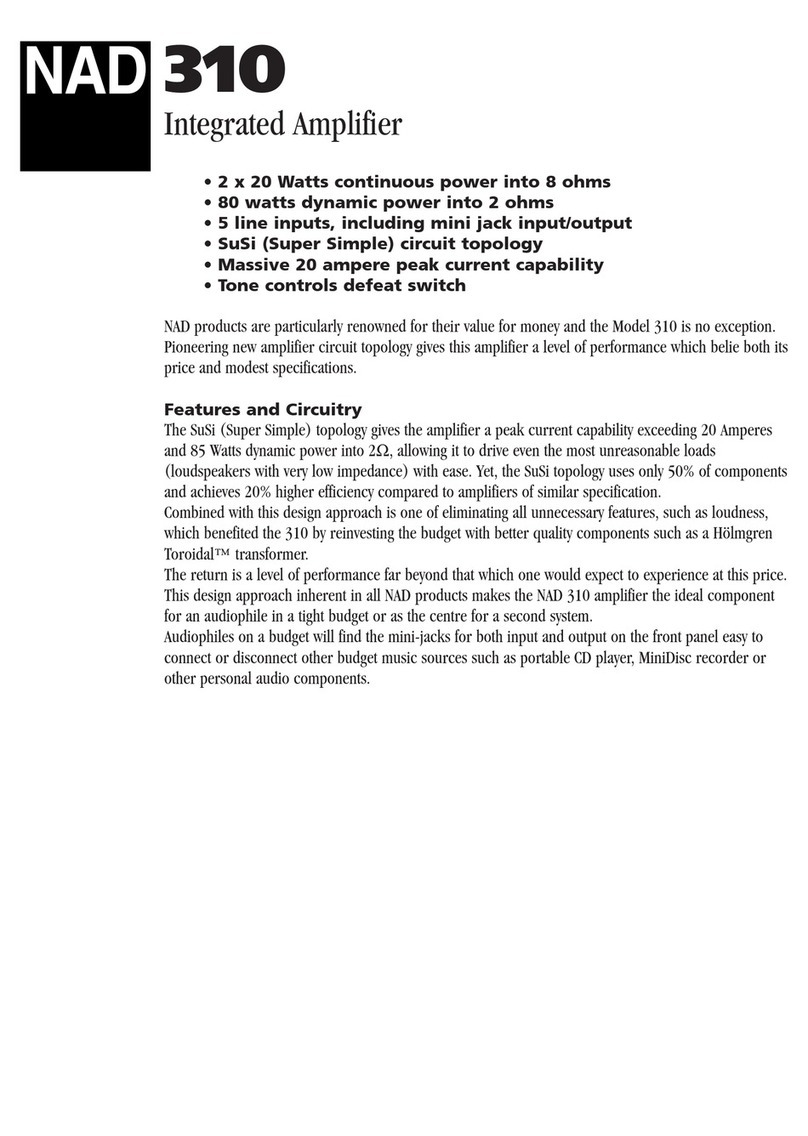
NAD
NAD 310 Specifications
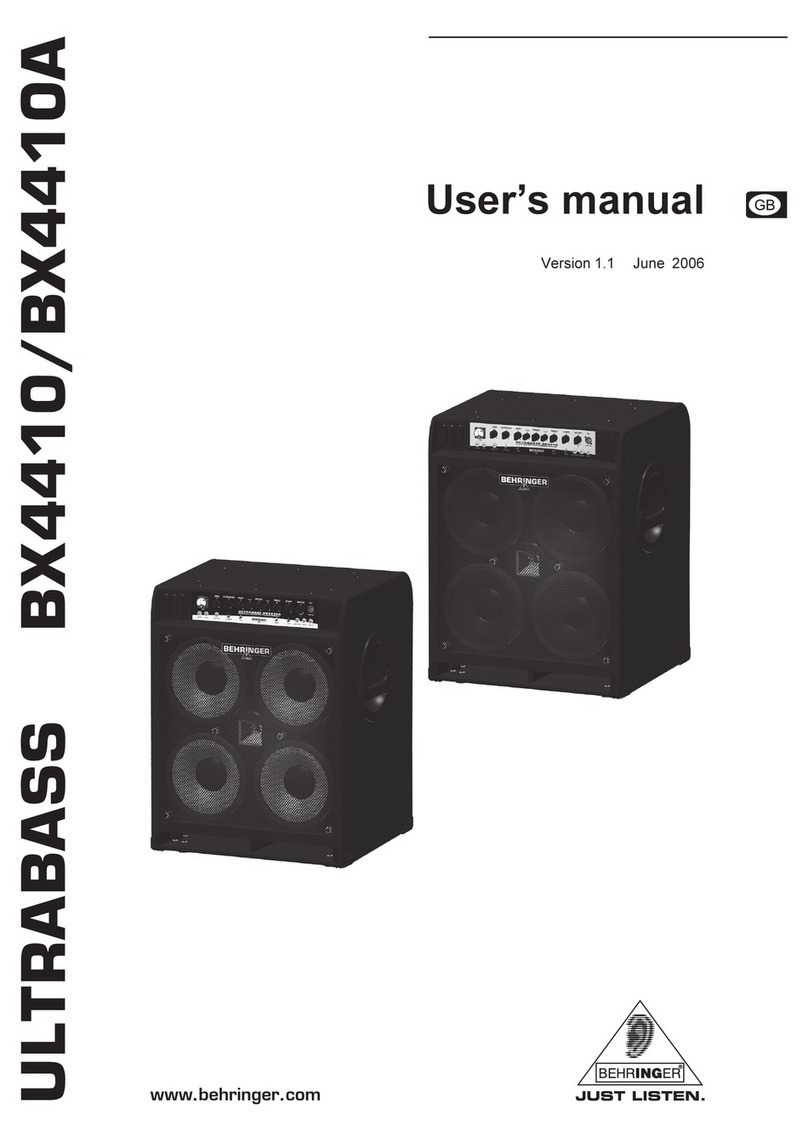
Behringer
Behringer Ultrabass BX4410 user manual

diytube
diytube stereo 35 Instructions for assembly operation

Raleigh Audio
Raleigh Audio RAKK dac Mark III Extreme Preamplifier Assembly manual
